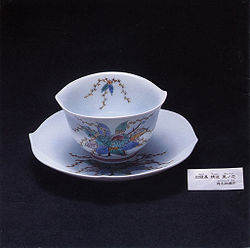Kalk Samen Kuri no Hana
- Artist
- Shiina Ringo
- Album
- Kalk Samen Kuri no Hana (加爾基 精液 栗ノ花; Lime Semen Chestnut Flower)
- Released
- 2003.02.23 (Copy Control)
- 2008.07.02 (Reissue)
- Catalog Number
- TOCT-24942 (Copy Control)
- TOCT-26578 (Reissue)
- Price
- ¥3,059
- Tracklist
- Shuukyou (宗教; Religion)
- Doppelgänger (ドッペルゲンガー)
- Meisai (迷彩; Camouflage)
- Odaiji ni (おだいじに; Please Take Care)
- Yattsuke Shigoto (やっつけ仕事; Rush Job)
- Kuki (茎; Stem)
- Torikoshi Gurou (とりこし苦労; Worrying Unnecessarily)
- Okonomi de (おこのみで; As You Wish)
- Ishiki (意識; Consciously)
- Poltergeist (ポルターガイスト; Poltergeists)
- Souretsu (葬列; Funeral)
- Ichijiku no Hana (映日紅の花(いちじくのはな; Fig Flower) (vinyl bonus track)
- Information
"Kalk Samen Kuri no Hana" is the third studio album by Shiina Ringo. The initial pressings of the album was released with Copy Control, and also included a sticker, under which is a message written by Shiina herself. The album reached #1 on the Oricon weekly charts and charted for 20 weeks. Because the album sold 409,000 units, it became the #28 album of 2003 in Japan. The album also reached #28 on the World Album Charts and managed to chart for two weeks.
Art Direction & Symmetry
All of the lyrics are written in an ancient Japanese style and over 30 different types of instruments are played on this album. Each song is mixed into one another, creating one cohesive track. Everything about the album seems to be perfected in a Japanese way, from the CD booklet being read from right to left and starting at what would be the back in Western CD booklets (this is usually only seen in Enka CDs), to the track numbering being labeled in formal kanji script usually only seen in legal documents (壱、弐、参、肆、伍、陸、漆、捌、玖、拾、拾壱). Shiina continues her tradition of symmetry from "Shouso Strip", in which the song titles are symmetrical to each other on opposite ends of the album; the album length is 44:44 ("Shouso Strip"'s album length was 55:55). In addition, each track symmetrically relates to another at the opposite edge of the album, as follows:
- "Shuukyou (1) and Souretsu" (11) - Both start with an 'S', and relate to religion. Shiina also sings is the same manner for these songs. The same orchestra, the Kuri no Hana Kahoru Orchestra (栗ノ花薫オーケストラ; Orchestra Scented with Chestnut Flowers) was used for both of the songs. The conductor was Gotou Yuuichirou (後藤 勇一郎), the violinist/composer of the band The Dynamites. Lyrically, it is interesting to note that "Shuukyou" references death while "Souretsu" references birth and rebirth.
- "Doppelgänger" (2) and "Poltergeist" (10) - Both are about the supernatural. As above, the Kuri no Hana Kahoru Orchestra was used for the background music. Both tracks have titles in katakana with the same number of characters. Both titles are words borrowed from German .
- "Meisai" (3) and "Ishiki" (9) - Both were found as B-sides on the Stem ~Daimyou Asobi Hen~ single, in the same order around "Stem". The same band was used for both these tracks, which was a temporary Shiina Ringo band called Himitsu Butai (秘密部隊), with Shiina Ringo as the conductor. Lyrically, the songs directly reference each other; "Meisai" mentions the word 'ishiki' and while "Ishiki" does not mention the word 'meisai' specifically, the English translation, "camouflage", is sung in katakana.
- "Odaiji ni" (4) and "Okonomi de" (8) - Both starting with the honorific 'o', coupled with a particle at the end and spelt completely in hiragana. The same instruments/background musicians are used for these two songs.
- "Yattsuke Shigoto" (5) and "Torikoshi Kurou" (7) - Thematically, there are no apparent similarities between these two songs other than having exactly the same kana/kanji structure (Four kana followed by two kanji) and perhaps that they are the most experimental and unusual songs from the album in terms of composition.
- "Kuki" (6) - Standing alone in the center, it was the only single released before the album. This version is identical to the one featured on the soundtrack to the film CASSHERN, but performed in Japanese, unlike the previous versions sung in English.
External Links
| |||||||||||||||||||||||||||||||||||||||

